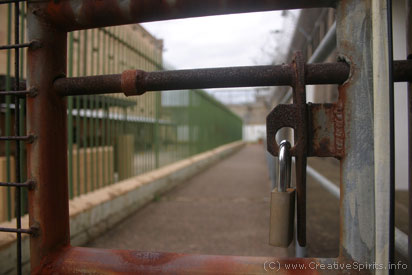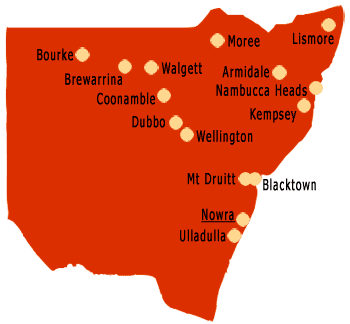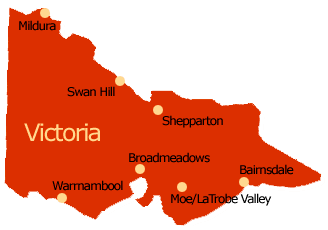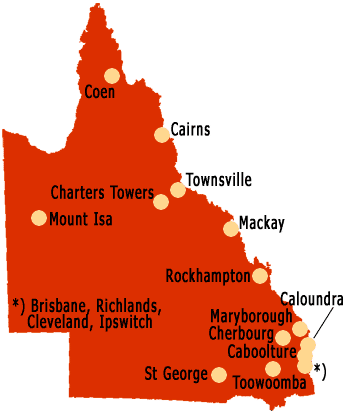Law & justice
Circle sentencing
Circle sentencing aims to avoid gaol time for Aboriginal offenders by bringing them together with elders. The offender must plead guilty, and punishments are not mild. The system has many benefits for all involved.

Wishing you knew more about Aboriginal culture? Search no more.
Get key foundational knowledge about Aboriginal culture in a fun and engaging way.
This is no ordinary resource: It includes a fictional story, quizzes, crosswords and even a treasure hunt.
Stop feeling bad about not knowing. Make it fun to know better.
Selected statistics
Circle sentencing has been identified as an extremely important program by Aboriginal Community Justice Groups because it breaks down barriers between the justice system and Aboriginal communities.
— John Hatzistergos, NSW Attorney-General [1]
What is 'circle sentencing'?
Imagine you have committed an offence and instead of going to court and jail you'll have to face a circle of Elders, representatives of your community, and your victim. This is the concept of 'circle sentencing'.
For a long time there has been no real improvement in the situation of Aboriginal people in jail, despite the Royal Commission into Aboriginal deaths in custody and its many recommendations.
Aboriginal People are over-represented in Australian jails. In 2019, 85% of the Northern Territory prison population was Aboriginal, [4] up from 80% in 2006. In addition, Aboriginal people in custody are often dying from treatable diseases like diabetes and heart disease.
A scheme which is called "circle sentencing" in NSW tries to avoid gaol time for Aboriginal offenders. The term 'circle sentencing' comes from a circle of representatives sitting together and trying to decide a sentence which does not include a jail term.
Representatives are mainly Aboriginal Elders, but also members of the prosecution or police and a magistrate. The circle will also talk about the background and effects of the offence and can involve meeting the victim. The sentence should, where possible, involve community work.
Sometimes it's harder for the offender to face his or her own people than to face a magistrate.
— Bob Moran, Aboriginal elder [5]

Circle sentencing is an idea which in 2002 spread to Australia from northern Canada where the procedure was resurrected in 1991 from traditional sanctioning and healing practices. [3]
Circle sentencing is part of the court process and results in convictions and criminal records for offenders.
In 2018 the Supreme Court of Victoria decided a defendant's request to be sentenced by a Koori court cannot be refused, a case which has been seen as the first proper consideration of Aboriginal cultural rights. The supreme court found that in certain court processes, Aboriginal cultural rights were a relevant factor for magistrates to consider. [6]
Unfortunately, the option of circle sentencing is often not told to juvenile offenders by police. [7]
Circle sentencing is not for everyone
Sentencing circles require a significant commitment from those community members who participate in the circle. To maximise the benefit of each circle sentencing process communities should only invite offenders who demonstrate high levels of motivation and commitment to the process.
The offender must normally enter a guilty plea early in the proceedings indicating a full acceptance of responsibility for the offence. Circles are not for people facing murder or sexual assault charges.
Circle sentencing is not an easy way out for offenders. Punishments tend to fall in the middle-to-heavy end of penalties. The program often involves culturally appropriate, intensive supervision of participants.
"Many Kooris who have been through the Koori Courts find the experience far more confronting than the mainstream courts," explains Rob Hulls, Victorian Deputy Premier and Attorney-General [8].
"The Elders are imposing but, rather than being adversarial, they help get to the cause of the criminal behaviour. This model is designed to break down the disengagement that Indigenous people have had with courts."
I have seen first-hand how this program establishes a relationship between offenders and Aboriginal Elders so that they are linked back to the community and programs that can help them.
— Maree Jennings, Circle Sentencing Project Officer, Mt Druitt [1]
Video: NSW's first Koori Youth Court trial
The ABC reports on New South Wales' first Koori court opening in November 2014.
Circle court is not a 'bush court'
Sometimes you might hear of a 'bush court' that works in very remote communities. These are not circle courts as they operate like a miniature version of a regular Western court.
Lawyers pack dozens of files and head out to these remote communities to deal with clients in rapid succession in makeshift courtrooms. No Aboriginal elders or media are present. The only people attending are the judge, some staff, the accused, an interpreter and defence counsel. Gardens outside community centres sometimes serve as interview rooms.
Bush courts offer young lawyers a chance to visit communities and interact with Aboriginal people for the first time, an opportunity to leave behind stereotypes learned far away from them. "These are the moments that they'll treasure for the rest of their lives," knows David Woodroffe, a principal legal officer of the North Australian Aboriginal Justice Agency. "It's what makes us more than being just a lawyer, it's about being a good bush court lawyer." [4]
But bush courts can also be a far way away from scrutiny which can work to the detriment of those facing the judge, and the small amount of time for each case makes hearing all versions of events a challenge, especially when English is not a first language.
How a circle sentencing process works
The proposed process during a circle court is as follows:
- Welcome: Aboriginal elders welcome all participants.
- The magistrate will welcome all participants to the circle and formally open proceedings.
- Introduction: Participants introduce themselves, explain who they are, their relationship with the defendant or victim or their interest in the offence.
- Magistrate explains the role of the circle, that it is a court and functions as a court.
- Magistrate explains methods of proceeding in the circle, the guidelines and the rule of conduct within the circle.
- Defendant statement: The defendant will make comment regarding the offence, themselves, their commitment to rehabilitation.
- The victim or a representative of the victim may make a statement regarding the impact of the offence.
- Circle discussion: The discussion should cover the offence, its impact on the victim and community, what needs to be done to right the wrong, what support may be available for the defendant and victim.
- Magistrate provides summary of circle discussion/decisions reached.
- Sentencing: Magistrate determines sentence.
- Support discussion: Support for defendant established, formal support group that will support offender is established.
- Support for victim established, support group for victim is established.
- Date for review set.
- Closing remarks, magistrate formally closes the circle.
| Formal court | Circle court | |
|---|---|---|
| What does the room look like? | Cold and impersonal | Aboriginal artwork and flags [9] |
| Who attends? | Justice system professionals | Elders, magistrate, police, community members |
| What decides sentence? | Legal principles and precedents | Offender's situation, victim's comments |
| Who talks most? | Lawyers | Those directly or indirectly affected by the crime |
| What is the result? | Convictions and criminal records, jail time | Convictions and criminal records, community work |
Story: Robert's pub fight
In 2002 Robert, an Aboriginal man from Nowra (about 200 kms south of Sydney), got involved in a pub fight and badly hit another person. With his previous convictions this would have put him into jail--again.
But Robert had the chance to participate in the first circle sentencing court in Nowra. He accepted.
Four Aboriginal elders, a magistrate, a police prosecutor and a defence solicitor listened to Robert's and the victim's version of what had happened that night in the pub. Robert learned about how terrifying the experience was for the victim and felt remorse.
The elders asked Robert how jail would feel—three months would be the usual sentence. The victim felt it was too much.
Eventually the sentencing circle court handed down their decision: Robert got six months' home detention [10].
Circle sentencing programs in NSW and Australia
Programs of circle sentencing run in NSW in the following towns (start year in brackets):
- Nowra (pilot introduced in 2002)
- Dubbo (2003)
- Brewarrina (2004)
- Walgett (2004)
- Bourke (2005)
- Armidale (2005)
- Lismore (2005)
- Mount Druitt (2006)
- Kempsey (2006)
- Nambucca Heads (2009)
- Moree (2010)
- Ulladulla (2010)
- Wellington (2010)
- Blacktown (2010)
- Coonamble (2010)

The selection of the locations was based on criteria that included the number of eligible Aboriginal defendants appearing in the Local Court, the number of Aboriginal defendants being sentenced to a term of imprisonment, Aboriginal community support for the program and local service infrastructure.
Later circle sentencing locations were established following consultations with Aboriginal communities.
Scheme names in other states or territories
Australian states and territories confusingly use different names for a similar scheme [11]:
| State | Scheme name |
|---|---|
| Australian Capital Territory | Ngambra Circle Court |
| New South Wales | Walama Court [12] (adults), Youth Koori Court |
| Northern Territory | Community Court |
| Queensland | Murri Court, Youth Murri Court |
| South Australia | Nunga Court, (Special) Aboriginal Court |
| Victoria | Koori Court |
| Western Australia | Circle Court, Aboriginal Court, Community Court |
Koori Courts in Victoria

Victoria's first County Koori Court launched in November 2008 at the Latrobe Valley court complex in Gippsland.
It is the first higher jurisdiction in Australia. Magistrate's Koori Courts operate already around Victoria (see map) and Children's Koori Courts are in Mildura and Melbourne [14]. The County Koori Court will sit once a month while the Magistrate's Koori Court sits once a fortnight.
The Shepparton Koori Court has a reoffending rate of about 12.5%, Broadmeadows reported 15.5% while the general court system has a rate of over 29% [14].
In November 2008 there were about 120 elders in Victoria's court system, in addition to about 60 Aboriginal people in the state's Department of Justice.
[Circle sentencing] has been a very effective tool in turning around the disastrous rate of Koori imprisonment in Victoria.
— Brian Tee, Labor MP [8]
Nunga Courts in South Australia
The Nunga Court in Port Adelaide, South Australia, celebrated its tenth anniversary in June 2009 after hearing more than 5,000 cases [15]. The court was the first of its kind in Australia.
"It has been so successful the rest of the nation has followed our lead and introduced similar court set-ups interstate," explains Michael Atkinson, South Australian Attorney General [15].
South Australian Nunga Courts operate at Port Adelaide (since June 1999), Port Augusta (2002), Murray Bridge (2001), Port Lincoln, Ceduna (2003) and a pilot program running at Berri.
Murri Courts in Queensland

The Murri Court, established in 2002, usually is a Queensland Magistrates or Children's Court.
By 2010, Murri Courts operate in 17 locations throughout Queensland. They include
- Brisbane
- Rockhampton
- Townsville
- Mount Isa
- Caboolture
- Coen
- Cherbourg
- Caloundra
- Cleveland
- Ipswich
- Cairns
- St George
- Mackay
- Richlands
- Charters Towers
- Maryborough
- Toowoomba
Aboriginal Community Courts in Western Australia
Western Australia's only Aboriginal court opened in Kalgoorlie [16] in November 2006. A more informal court operates at Norseman, near Kalgoorlie [17].
Benefits of circle sentencing
Some benefits of circle sentencing include:
- Local scope: Circle sentencing helps people to address and correct criminal behaviour within their local communities.
- Break the cycle: It reduces the likelihood to re-offend and enter a criminal career.
- Personal hearings: There is no dominance of legal professionals or hierarchies of traditional court rooms, all participants are able to fully participate and to speak for themselves.
- Easy understanding: Legal jargon is removed from the court, the language of the community becomes the language of the court.
- Holistic approach: The court receives information about the whole community, the background to the offenders, the impact of the offence on the victim, the problems experienced by the local community.
- Racial bias reduced: Community participation greatly removes racial bias in the court and in the sentence.
- Offender participation: Circle courts actively encourage the participation of the offender and those who know him or her best.
- Victim participation: Circle courts allow the offender to get a full perspective of the effects of their actions on the victim, the offender is directly confronted with the hurt experienced by the victim.
- Away from court rooms: Court rooms can be intimidating for Aboriginal people. If circles are held away from courts people are more likely to open up to elders.
You're actually sitting there telling people that live just down the road from you or just around the corner and you can't be telling them untruths because they know what you're doing and they know how you operate in that community.
— Victor Darcy, Kempsey Circle sentencing project officer
There is widespread agreement that Koori Courts in Victoria, Murri Courts in Queensland and circle sentencing in New South Wales facilitate culturally appropriate ways of proceeding with young Aboriginal offenders [18][19]. They also have a beneficial flow-on effect for the wider Aboriginal community where people "feel as if they are being treated seriously and having their culture respected," [18] which might be the most important effect of these courts.

Circle sentencing success stories
Some examples of the program's success:
- Robert B. of Nowra, the first to go through a circle, despite at least eight previous custodial terms, had not re-offended sixteen months later [10].
- Only 4 of the 50 offenders sentenced in the circle court have re-offended in Dubbo.
- 10 out of 37 offenders have re-offended in Nowra.
- The numbers of Koori offenders appearing on list days at Nowra Local Court were reduced from 23% to 6%.
- Re-offending rates dropped by 15.5% in one Victorian town [9].
- One victim, the proprietor of a motor vehicle shop in Nowra, sponsored the local Aboriginal football team after his involvement in the program as he recognised the potential of such activities for reducing the likelihood of Aboriginal offenders re-offending.
[Circle sentencing is] one of the best things that has happened to Aboriginal people today.
— Nora Roberts, Nowra elder
The word has spread and a lot of Aboriginal men and women want to have their matters heard in a more culturally relevant way, even though it is not customary law.
— Reverend Alex Gator [19]
Circle sentencing criticism
Although some data indicates that circle sentencing reduces recidivism rates, other reports found little or no improvements compared to ordinary courts [19][2].
Circle sentencing works well for individual offenders, but if many community members are involved in an offence, such as during a riot, the system is less appropriate. In that case it might also be hard to find elders to sit on the court who are impartial [20].
The fact that people entering the circle sentencing system have to plead guilty is also a matter of concern. Critics demand that instead the crown should establish a person's guilt or innocence. The circle sentencing system should not be a "cosmetic adjunct" to the court system [19].
A 2008 analysis of the program using a small sample group of offenders found that the process did not address the root cause of the offenders' criminal behaviour, such as drugs and alcohol.[2]
There will always be a certain class of offender who is not guilty of offences they're charged with [but] will plead guilty anyway to access the Murri Court process.
— Sam Watson, Aboriginal author and activist [19]
Related resources

In 2007 SBS television broadcast a six-episode mini-series about a circuit court, set in Broome, Western Australia, which is available on DVD.
The award-winning series explored the daily work of a court lawyer who has to travel vast distances to deal with cases in remote communities.
Read about the six 2008 episodes of The Circuit.

The Judicial Commission of New South Wales has produced Circle Sentencing in NSW, a DVD primarily designed as an educational tool for judicial officers but also useful for other participants in circle sentencing, including police prosecutors, defence lawyers, project officers and Aboriginal elders.
It explains how circle sentencing works, how to go about it and its benefits. You can order the DVD on the Judicial Commission's website.